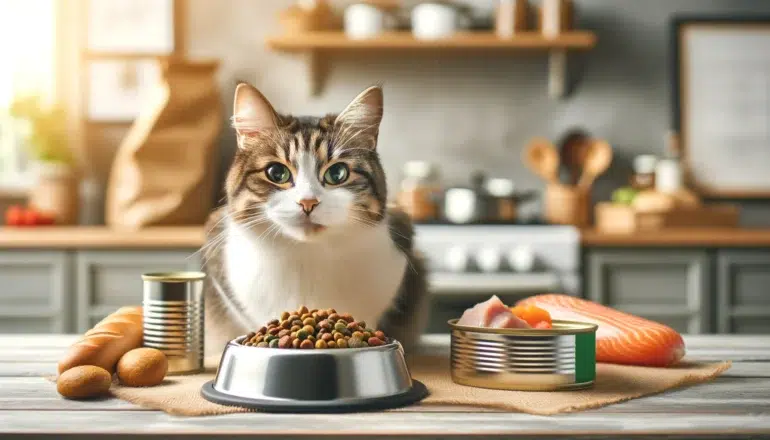As a cat owner, ensuring your feline friend enjoys a long, healthy, and happy life is a top priority. One of the most crucial aspects of your cat’s well-being is their diet. With a plethora of cat food options on the market, selecting the right one can be a daunting task. From deciphering ingredient lists to understanding nutritional needs at different life stages, there’s a lot to consider. In this article, we’ll unlock the secrets to choosing the right food for your cat, providing you with the knowledge and confidence to make informed decisions that will keep your cat purring with delight.
Table of Contents
Understanding Your Cat’s Nutritional Needs
The foundation of good cat nutrition lies in understanding what your feline friend needs to thrive. Unlike dogs, cats are obligate carnivores, which means their diet must be rich in animal-based proteins. Proteins provide essential amino acids that cats cannot produce on their own. Alongside proteins, cats require fats for energy and essential fatty acids, as well as vitamins and minerals to support overall health.
Life Stages and Their Dietary Requirements
Kittens
Kittens are bundles of energy, and their growing bodies need a diet packed with nutrients. High-protein foods with added fats are crucial for their development. Look for kitten-specific formulas that include DHA for brain development and antioxidants for immune support.
Adult Cats
Once cats reach adulthood, their nutritional needs shift to maintenance. A balanced diet that supports their energy levels and maintains a healthy weight is essential. Protein remains important, but adult cats also need a mix of fats and fibers to keep their digestive systems in check.
Senior Cats
Aging cats often face health challenges that can be managed with the right diet. Senior cat foods are designed to be easier to digest and may include supplements like glucosamine for joint health and antioxidants to combat age-related diseases.
Types of Cat Food
Dry Food
Dry cat food, or kibble, is convenient and has a long shelf life. It’s beneficial for dental health as it can help reduce tartar buildup. However, it’s important to ensure that your cat drinks plenty of water, as dry food alone doesn’t provide sufficient hydration.
Wet Food
Wet food is highly palatable and hydrating, making it an excellent choice for cats that need extra moisture in their diet. It can be more expensive and has a shorter shelf life once opened, but many cats prefer the taste and texture.
Raw and Homemade Diets
Raw and homemade diets are becoming increasingly popular among cat owners. These diets can offer high nutritional value but require careful planning and preparation to ensure they meet all of your cat’s nutritional needs. It’s crucial to consult with a veterinarian before switching to a raw or homemade diet.
Prescription Diets
For cats with specific health issues, prescription diets formulated by veterinarians can be a lifesaver. These diets are tailored to manage conditions such as kidney disease, diabetes, and allergies.
Reading Cat Food Labels
Deciphering cat food labels can be tricky, but it’s essential for making informed choices. Look for foods that list high-quality animal proteins as the first ingredient. Avoid products with excessive fillers like corn, wheat, and soy. The guaranteed analysis section provides information on nutrient content, while the nutritional adequacy statement ensures the food meets the required standards for a balanced diet.
Special Dietary Considerations
Allergies and Food Sensitivities
If your cat shows signs of food allergies, such as itching, vomiting, or diarrhea, it’s crucial to identify and eliminate the offending ingredient. Hypoallergenic diets or limited ingredient foods can help manage these sensitivities.
Weight Management
Maintaining an ideal weight is vital for your cat’s health. For overweight cats, look for foods labeled as weight management or light. Conversely, underweight cats may benefit from high-calorie, nutrient-dense diets.
Health Conditions
Certain health conditions require specialized diets. For example, diabetic cats may need low-carbohydrate foods, while those with kidney disease often benefit from low-phosphorus diets. Always consult your vet for dietary recommendations tailored to your cat’s specific health needs.
Tips for Transitioning to a New Diet
Switching your cat’s food should be done gradually to avoid digestive upset. Start by mixing a small amount of the new food with the old, gradually increasing the new food’s proportion over 7-10 days. Monitor your cat for any adverse reactions and consult your vet if you encounter persistent issues.
Consulting with Your Veterinarian
Your veterinarian is an invaluable resource when it comes to your cat’s nutrition. Regular check-ups can help identify any dietary adjustments needed to maintain optimal health. Don’t hesitate to ask your vet about the best food choices for your cat’s specific needs.
Conclusion
Choosing the right food for your cat is a key component of their overall health and happiness. By understanding their nutritional needs, selecting appropriate food types, and consulting with your veterinarian, you can ensure your feline friend enjoys a long, vibrant life. Make informed choices, and watch as your healthy cat thrives.





